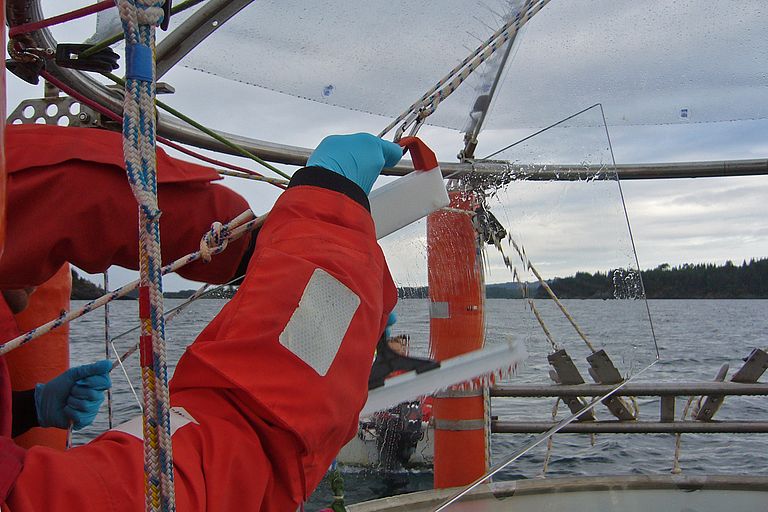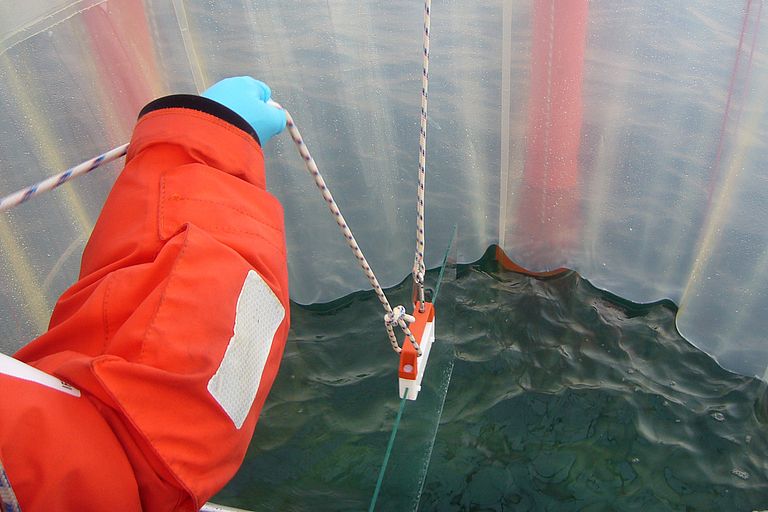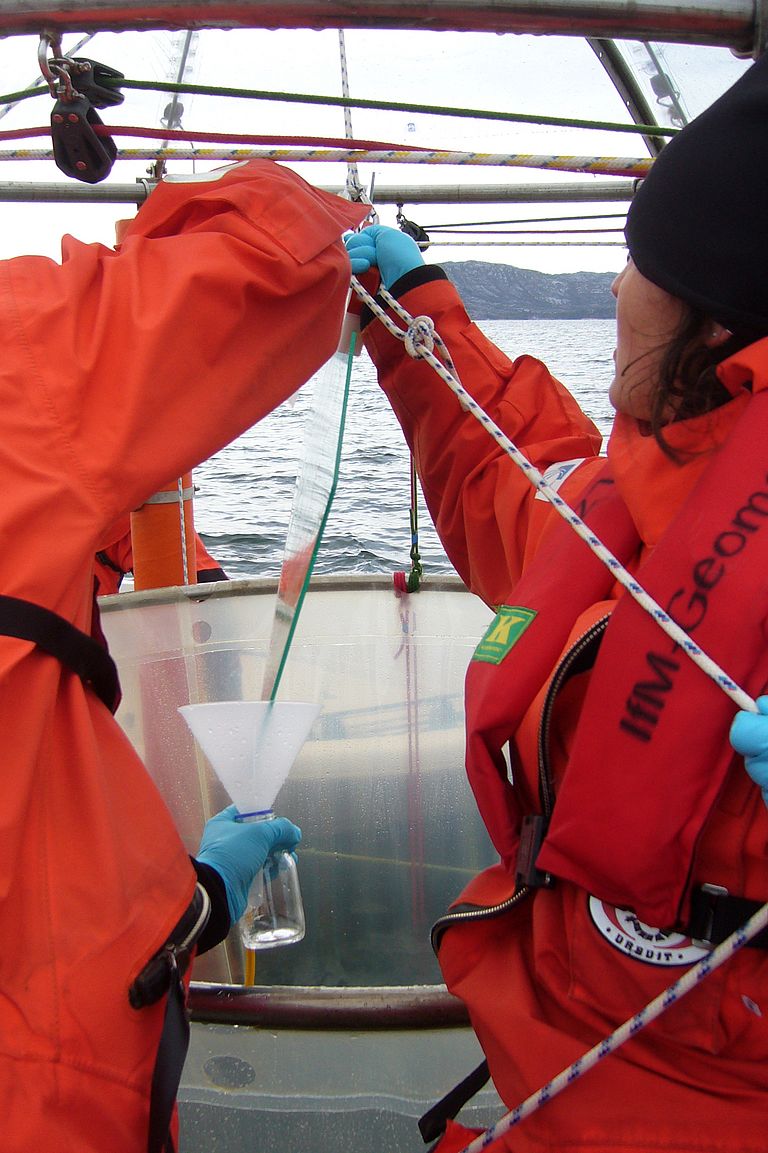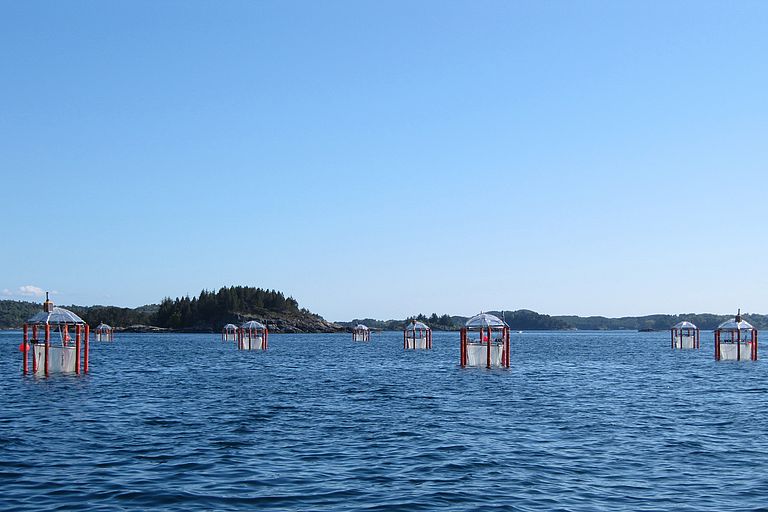The oceans’ sensitive skin
Ocean acidification affects climate-relevant functions at the sea-surface microlayer
Like a skin, the sea-surface microlayer separates the ocean from the atmosphere. The exchange of gases and the emission of sea-spray aerosols – two functions that are crucial for climate – take place in this boundary film. A mesocosm experiment by scientists from GEOMAR Helmholtz Centre for Ocean Research Kiel, Alfred Wegener Institute, Helmholtz Centre for Polar and Marine Research Bremerhaven (AWI) and the Institute for Baltic Sea Research Warnemünde (IOW) reveals for the first time how ocean change might affect the special physical, chemical and biological characteristics of the ocean’s uppermost boundary. The results are published in the “Journal of Geophysical Research: Oceans”. First author is Dr. Luisa Galgani who conducted the study as part of her PhD at GEOMAR and AWI.
“Experiments have shown how ocean acidification, a change in the ocean chemistry due to the uptake of man-made carbon dioxide, influences the growth and efficiency of marine bacteria as well as the sinking of carbon-rich particles”, Dr. Luisa Galgani resumes. “We know that organic material and microorganisms accumulating in the sea-surface microlayer are similar to those found in the water column below. So we expected that ocean acidification-driven changes in ocean biogeochemistry in the water column can also be reflected in the microlayer. It is important to understand changes in this microenvironment, because it might have consequences for air-sea interactions that are relevant for our climate.”
To investigate consequences of ocean acidification on marine systems, future ocean scenarios have been simulated with the KOSMOS mesocosms (KOSMOS: Kiel Off-Shore Mesocosms for future Ocean Simulations) at Raunefjord, Norway. These nine large floating structures, each of which isolates 75.000 litres of seawater, were brought to different carbon dioxide (CO2) levels as to be expected for upcoming decades and centuries. For one month, the surface of six mesocosms was sampled daily with a glass plate.
Analyses of the samples verified that organic compounds in the sea-surface microlayer reflected the temporal development of phytoplankton growth in the water column. Also, at higher CO2 levels, the concentrations of bacterioneuston, marine bacteria inhabiting the surface, increased. More acidic conditions promoted changes in the dynamics of organic matter. Especially proteinaceous marine gels became smaller but more abundant probably because they served as a nutritional substrate in the sea-surface microlayer, where higher abundances of microorganisms were more efficient in degrading the organic material accumulated during a phytoplankton bloom.
“From previous studies we know that the activity of marine bacteria is stimulated at high CO2”, Dr. Galgani explains. “Based on our observations in the sea-surface microlayer, we think that this could be very important as it may imply a positive feedback on atmospheric CO2 from oceanic sources, that is, from microbial metabolism at the air-sea interface.”
Additionally, stimulated bacterial degradation might heavily affect the organic composition of nascent sea-spray particles, upon which relies the ability of marine aerosols to interact with the climate system. In the era of climate change, the contribution of marine aerosols is still poorly understood. “There is a long way ahead before we can determine how the ocean provides raw material for clouds formation”, Prof. Dr. Anja Engel, head of the research group Microbial Biogeochemistry at GEOMAR, states. “However, we think that our study provided an additional piece of the puzzle and we are directing our research in investigating more the structure and the dynamics of the air-sea interface to better estimate ocean-atmosphere interactions in a high CO2 world.”
The work was supported by the projects SOPRAN (Surface Ocean Processes in the Anthropocene) and BIOACID (Biological impacts of Ocean Acidification), both funded by the Bundesminsterium für Bildung und Forschung (BMBF) and is a contribution to the international SOLAS project (Surface Ocean - Lower Atmosphere Study).
Original publication:
Galgani, L., Stolle. C., Endres, S., Schulz, K. G., Engel, A. (2014), Effects of ocean acidification on the biogenic composition of the seasurface microlayer: Results from a mesocosm study, J. Geophys. Res. Oceans, 119, doi: 10.1002/2014JC010188.
Links:
BIOACID (Biological Impacts of Ocean Acidification)
SOPRAN (Surface Ocean Processes in the Anthropocene)
SOLAS (Surface Ocean - Lower Atmosphere Study)
Alfred Wegener Institute, Helmholtz Centre for Polar and Marine Research Bremerhaven
Leibniz Institute for Baltic Sea Research Warnemünde
Contact:
Maike Nicolai (GEOMAR Communication & Media), Tel.: +49 431-600-2807, mnicolai(at)geomar.de






